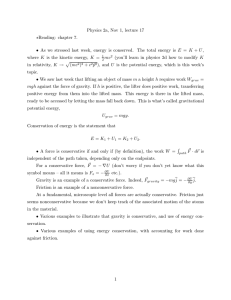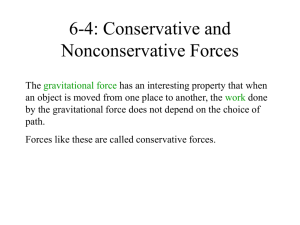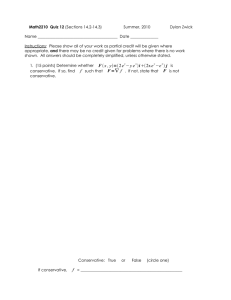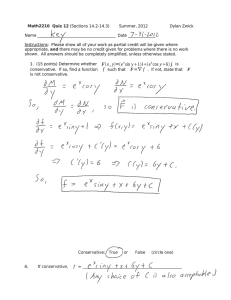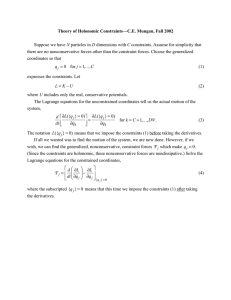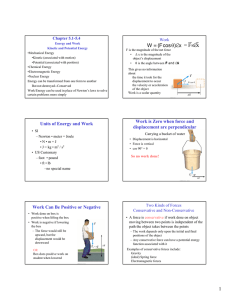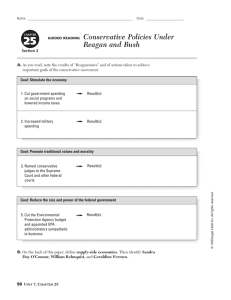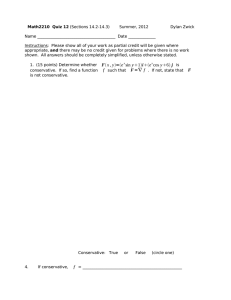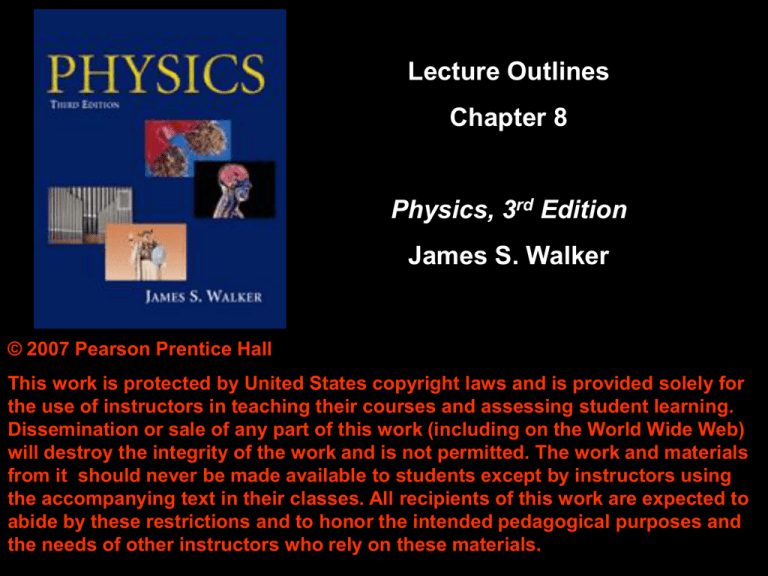
Lecture Outlines
Chapter 8
Physics, 3rd Edition
James S. Walker
© 2007 Pearson Prentice Hall
This work is protected by United States copyright laws and is provided solely for
the use of instructors in teaching their courses and assessing student learning.
Dissemination or sale of any part of this work (including on the World Wide Web)
will destroy the integrity of the work and is not permitted. The work and materials
from it should never be made available to students except by instructors using
the accompanying text in their classes. All recipients of this work are expected to
abide by these restrictions and to honor the intended pedagogical purposes and
the needs of other instructors who rely on these materials.
Chapter 8
Potential Energy and
Conservation of Energy
Units of Chapter 8
• Conservative and Nonconservative
Forces
• Potential Energy and the Work Done by
Conservative Forces
• Conservation of Mechanical Energy
• Work Done by Nonconservative Forces
• Potential Energy Curves and
Equipotentials
8-1 Conservative and Nonconservative
Forces
Conservative force: the work it does is stored in
the form of energy that can be released at a later
time
Example of a conservative force: gravity
Example of a nonconservative force: friction
Also: the work done by a conservative force
moving an object around a closed path is zero;
this is not true for a nonconservative force
8-1 Conservative and Nonconservative
Forces
Work done by gravity on a closed path is zero:
8-1 Conservative and Nonconservative
Forces
Work done by friction on a closed path is not
zero:
8-1 Conservative and Nonconservative
Forces
The work done by a conservative force is zero
on any closed path:
8-2 The Work Done by Conservative Forces
If we pick up a ball and put it on the shelf, we
have done work on the ball. We can get that
energy back if the ball falls back off the shelf; in
the meantime, we say the energy is stored as
potential energy.
(8-1)
8-2 The Work Done by Conservative Forces
Gravitational potential energy:
8-2 The Work Done by Conservative Forces
Springs:
(8-4)
8-3 Conservation of Mechanical Energy
Definition of mechanical energy:
(8-6)
Using this definition and considering only
conservative forces, we find:
Or equivalently:
8-3 Conservation of Mechanical Energy
Energy conservation can make kinematics
problems much easier to solve:
8-4 Work Done by Nonconservative Forces
In the presence of nonconservative forces, the
total mechanical energy is not conserved:
Solving,
(8-9)
8-4 Work Done by Nonconservative Forces
In this example, the
nonconservative force
is water resistance:
8-5 Potential Energy Curves and
Equipotentials
The curve of a hill or a roller coaster is itself
essentially a plot of the gravitational
potential energy:
8-5 Potential Energy Curves and
Equipotentials
The potential energy curve for a spring:
8-5 Potential Energy Curves and
Equipotentials
Contour maps are also a form of potential
energy curve:
Summary of Chapter 8
• Conservative forces conserve mechanical
energy
• Nonconservative forces convert mechanical
energy into other forms
• Conservative force does zero work on any
closed path
• Work done by a conservative force is
independent of path
• Conservative forces: gravity, spring
Summary of Chapter 8
• Work done by nonconservative force on closed
path is not zero, and depends on the path
• Nonconservative forces: friction, air
resistance, tension
• Energy in the form of potential energy can be
converted to kinetic or other forms
• Work done by a conservative force is the
negative of the change in the potential energy
• Gravity: U = mgy
• Spring: U = ½ kx2
Summary of Chapter 8
• Mechanical energy is the sum of the kinetic and
potential energies; it is conserved only in
systems with purely conservative forces
• Nonconservative forces change a system’s
mechanical energy
• Work done by nonconservative forces equals
change in a system’s mechanical energy
• Potential energy curve: U vs. position

